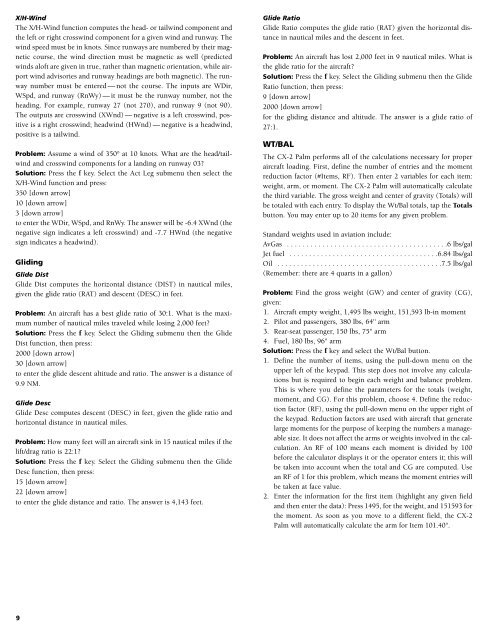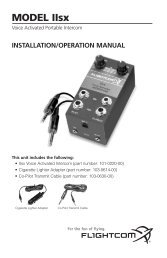You also want an ePaper? Increase the reach of your titles
YUMPU automatically turns print PDFs into web optimized ePapers that Google loves.
X/H-Wind<br />
The X/H-Wind function computes the head- or tailwind component and<br />
the left or right crosswind component for a given wind and runway. The<br />
wind speed must be in knots. Since runways are numbered by their magnetic<br />
course, the wind direction must be magnetic as well (predicted<br />
winds aloft are given in true, rather than magnetic orientation, while airport<br />
wind advisories and runway headings are both magnetic). The runway<br />
number must be entered — not the course. The inputs are WDir,<br />
WSpd, and runway (RnWy) — it must be the runway number, not the<br />
heading. For example, runway 27 (not 270), and runway 9 (not 90).<br />
The outputs are crosswind (XWnd) — negative is a left crosswind, positive<br />
is a right crosswind; headwind (HWnd) — negative is a headwind,<br />
positive is a tailwind.<br />
Problem: Assume a wind of 350° at 10 knots. What are the head/tailwind<br />
and crosswind components for a landing on runway 03?<br />
Solution: Press the f key. Select the Act Leg submenu then select the<br />
X/H-Wind function and press:<br />
350 [down arrow]<br />
10 [down arrow]<br />
3 [down arrow]<br />
to enter the WDir, WSpd, and RnWy. The answer will be -6.4 XWnd (the<br />
negative sign indicates a left crosswind) and -7.7 HWnd (the negative<br />
sign indicates a headwind).<br />
Gliding<br />
Glide Dist<br />
Glide Dist computes the horizontal distance (DIST) in nautical miles,<br />
given the glide ratio (RAT) and descent (DESC) in feet.<br />
Problem: An aircraft has a best glide ratio of 30:1. What is the maximum<br />
number of nautical miles traveled while losing 2,000 feet?<br />
Solution: Press the f key. Select the Gliding submenu then the Glide<br />
Dist function, then press:<br />
2000 [down arrow]<br />
30 [down arrow]<br />
to enter the glide descent altitude and ratio. The answer is a distance of<br />
9.9 NM.<br />
Glide Desc<br />
Glide Desc computes descent (DESC) in feet, given the glide ratio and<br />
horizontal distance in nautical miles.<br />
Problem: How many feet will an aircraft sink in 15 nautical miles if the<br />
lift/drag ratio is 22:1?<br />
Solution: Press the f key. Select the Gliding submenu then the Glide<br />
Desc function, then press:<br />
15 [down arrow]<br />
22 [down arrow]<br />
to enter the glide distance and ratio. The answer is 4,143 feet.<br />
9<br />
Glide Ratio<br />
Glide Ratio computes the glide ratio (RAT) given the horizontal distance<br />
in nautical miles and the descent in feet.<br />
Problem: An aircraft has lost 2,000 feet in 9 nautical miles. What is<br />
the glide ratio for the aircraft?<br />
Solution: Press the f key. Select the Gliding submenu then the Glide<br />
Ratio function, then press:<br />
9 [down arrow]<br />
2000 [down arrow]<br />
for the gliding distance and altitude. The answer is a glide ratio of<br />
27:1.<br />
WT/BAL<br />
The <strong>CX</strong>-2 Palm performs all of the calculations necessary for proper<br />
aircraft loading. First, define the number of entries and the moment<br />
reduction factor (#Items, RF). Then enter 2 variables for each item:<br />
weight, arm, or moment. The <strong>CX</strong>-2 Palm will automatically calculate<br />
the third variable. The gross weight and center of gravity (Totals) will<br />
be totaled with each entry. To display the Wt/Bal totals, tap the Totals<br />
button. You may enter up to 20 items for any given problem.<br />
Standard weights used in aviation include:<br />
AvGas . . . . . . . . . . . . . . . . . . . . . . . . . . . . . . . . . . . . . . . . .6 lbs/gal<br />
Jet fuel . . . . . . . . . . . . . . . . . . . . . . . . . . . . . . . . . . . . . .6.84 lbs/gal<br />
Oil . . . . . . . . . . . . . . . . . . . . . . . . . . . . . . . . . . . . . . . . . .7.5 lbs/gal<br />
(Remember: there are 4 quarts in a gallon)<br />
Problem: Find the gross weight (GW) and center of gravity (CG),<br />
given:<br />
1. Aircraft empty weight, 1,495 lbs weight, 151,593 lb-in moment<br />
2. Pilot and passengers, 380 lbs, 64'' arm<br />
3. Rear-seat passenger, 150 lbs, 75'' arm<br />
4. Fuel, 180 lbs, 96'' arm<br />
Solution: Press the f key and select the Wt/Bal button.<br />
1. Define the number of items, using the pull-down menu on the<br />
upper left of the keypad. This step does not involve any calculations<br />
but is required to begin each weight and balance problem.<br />
This is where you define the parameters for the totals (weight,<br />
moment, and CG). For this problem, choose 4. Define the reduction<br />
factor (RF), using the pull-down menu on the upper right of<br />
the keypad. Reduction factors are used with aircraft that generate<br />
large moments for the purpose of keeping the numbers a manageable<br />
size. It does not affect the arms or weights involved in the calculation.<br />
An RF of 100 means each moment is divided by 100<br />
before the calculator displays it or the operator enters it; this will<br />
be taken into account when the total and CG are computed. Use<br />
an RF of 1 for this problem, which means the moment entries will<br />
be taken at face value.<br />
2. Enter the information for the first item (highlight any given field<br />
and then enter the data): Press 1495, for the weight, and 151593 for<br />
the moment. As soon as you move to a different field, the <strong>CX</strong>-2<br />
Palm will automatically calculate the arm for Item 101.40''.






